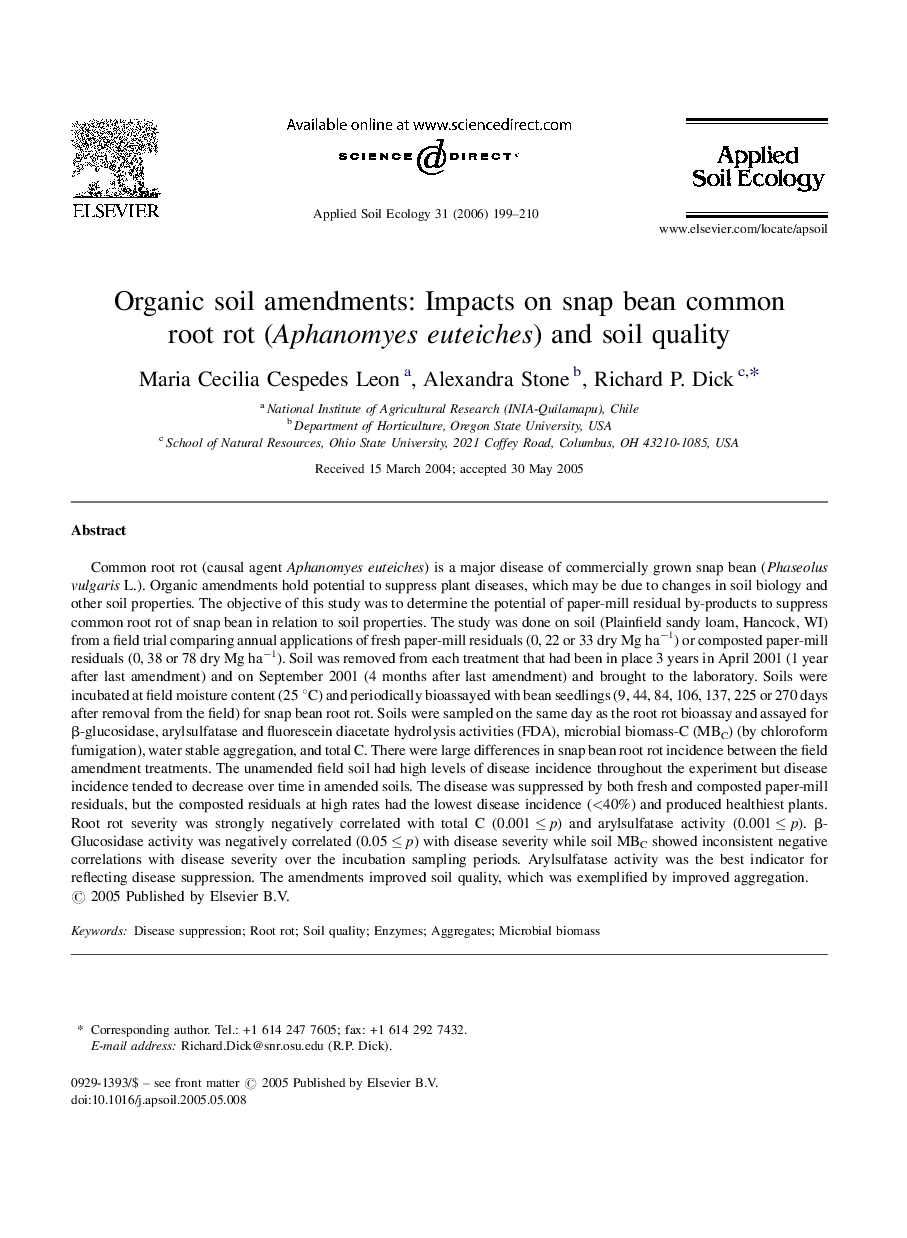| کد مقاله | کد نشریه | سال انتشار | مقاله انگلیسی | نسخه تمام متن |
|---|---|---|---|---|
| 4383455 | 1304267 | 2006 | 12 صفحه PDF | دانلود رایگان |
عنوان انگلیسی مقاله ISI
Organic soil amendments: Impacts on snap bean common root rot (Aphanomyes euteiches) and soil quality
دانلود مقاله + سفارش ترجمه
دانلود مقاله ISI انگلیسی
رایگان برای ایرانیان
کلمات کلیدی
موضوعات مرتبط
علوم زیستی و بیوفناوری
علوم کشاورزی و بیولوژیک
بوم شناسی، تکامل، رفتار و سامانه شناسی
پیش نمایش صفحه اول مقاله

چکیده انگلیسی
Common root rot (causal agent Aphanomyes euteiches) is a major disease of commercially grown snap bean (Phaseolus vulgaris L.). Organic amendments hold potential to suppress plant diseases, which may be due to changes in soil biology and other soil properties. The objective of this study was to determine the potential of paper-mill residual by-products to suppress common root rot of snap bean in relation to soil properties. The study was done on soil (Plainfield sandy loam, Hancock, WI) from a field trial comparing annual applications of fresh paper-mill residuals (0, 22 or 33 dry Mg haâ1) or composted paper-mill residuals (0, 38 or 78 dry Mg haâ1). Soil was removed from each treatment that had been in place 3 years in April 2001 (1 year after last amendment) and on September 2001 (4 months after last amendment) and brought to the laboratory. Soils were incubated at field moisture content (25 °C) and periodically bioassayed with bean seedlings (9, 44, 84, 106, 137, 225 or 270 days after removal from the field) for snap bean root rot. Soils were sampled on the same day as the root rot bioassay and assayed for β-glucosidase, arylsulfatase and fluorescein diacetate hydrolysis activities (FDA), microbial biomass-C (MBC) (by chloroform fumigation), water stable aggregation, and total C. There were large differences in snap bean root rot incidence between the field amendment treatments. The unamended field soil had high levels of disease incidence throughout the experiment but disease incidence tended to decrease over time in amended soils. The disease was suppressed by both fresh and composted paper-mill residuals, but the composted residuals at high rates had the lowest disease incidence (<40%) and produced healthiest plants. Root rot severity was strongly negatively correlated with total C (0.001 â¤Â p) and arylsulfatase activity (0.001 â¤Â p). β-Glucosidase activity was negatively correlated (0.05 â¤Â p) with disease severity while soil MBC showed inconsistent negative correlations with disease severity over the incubation sampling periods. Arylsulfatase activity was the best indicator for reflecting disease suppression. The amendments improved soil quality, which was exemplified by improved aggregation.
ناشر
Database: Elsevier - ScienceDirect (ساینس دایرکت)
Journal: Applied Soil Ecology - Volume 31, Issue 3, March 2006, Pages 199-210
Journal: Applied Soil Ecology - Volume 31, Issue 3, March 2006, Pages 199-210
نویسندگان
Maria Cecilia Cespedes Leon, Alexandra Stone, Richard P. Dick,